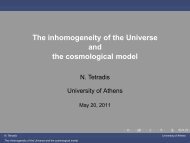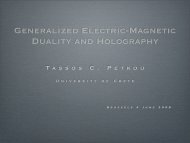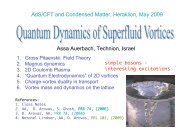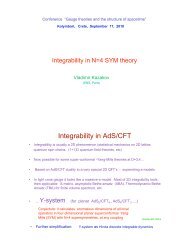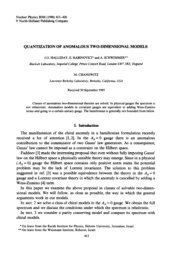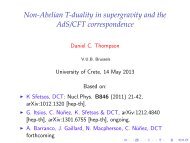Claudia de Rham - Crete Center for Theoretical Physics
Claudia de Rham - Crete Center for Theoretical Physics
Claudia de Rham - Crete Center for Theoretical Physics
You also want an ePaper? Increase the reach of your titles
YUMPU automatically turns print PDFs into web optimized ePapers that Google loves.
The BD Ghost inmassive Gravity<strong>Crete</strong> <strong>Center</strong> <strong>for</strong> <strong>Theoretical</strong> <strong>Physics</strong>April, 15 th 2011<strong>Claudia</strong> <strong>de</strong> <strong>Rham</strong>Work withGregory Gabadadze and Andrew Tolley
Why Massive Gravity ?PhenomenologySelf-accelerationC.C. Problem
Why Massive Gravity ?Phenomenologywhat are the theoretical and observational bounds on gravity in the IR ?mass of the photon is boun<strong>de</strong>d to m g < 10 -25 GeV,how about the graviton?Can we construct a consistent theory <strong>for</strong>a massive spin-2 field ?
Why Massive Gravity ?Phenomenologywhat are the theoretical and observational bounds on gravity in the IR ?mass of the photon is boun<strong>de</strong>d to m g < 10 -25 GeV,how about the graviton?Self-accelerationCould dark energy be due to an IR modification of gravity?with no ghosts ... ?C.C. ProblemDeffayet, Dvali, Gabadadze, „01Koyama, „05
Why Massive Gravity ?Phenomenologywhat are the theoretical and observational bounds on gravity in the IR ?mass of the photon is boun<strong>de</strong>d to m g < 10 -25 GeV,how about the graviton?Self-accelerationCould dark energy be due to an IR modification of gravity?with no ghosts ... ?C.C. ProblemIs the cosmological constant small ?ORdoes it have a small effect on the geometry ?Arkani-Hamed, Dimopoulos, Dvali &Gabadadze, „02Dvali, Hofmann & Khoury, „07
Massive GravityA massless spin-2 field in 4d, has 2 dofA massive spin-2 field, has 5 dof
Strong Coupling5 th <strong>for</strong>ce constraints in the solar system imply that theextra <strong>de</strong>grees of freedom must be strongly coupled at ascaler Sr *
Boulware-Deser GhostNon-linearities are fundamental <strong>for</strong> the survival of the theory.But non-linearly, the theory seems to contain a ghost, whichhas been shown explicitly1. In the ADM <strong>for</strong>malism,counting constraints in Hamiltonian2. In the Stückelberg language,- In the <strong>de</strong>coupling limit (ghost scale ~ L)- At higher scales
1. ADM in GRThe ghost of massive gravity was originally pointed outby Boulware and Deser, using the ADM <strong>de</strong>compositionIn GR, both the lapse and shifts play the role of Lagrangemultipliers, propagating 4 constraints
1. ADM in GRThe ghost of massive gravity was originally pointed outby Boulware and Deser, using the ADM <strong>de</strong>compositionIn GR, the lapse and shifts play the role of Lagrange mult.symmetryconstraints
1. BD Ghost in ADMIn massive gravity, both the lapse and shifts enter non-linearlyThe Fierz-Pauli combination, ensures that the lapse remainslinear at the quadratic or<strong>de</strong>r,
1. BD Ghost in ADMIn massive gravity, both the lapse and shifts enter non-linearlyThe Fierz-Pauli combination, ensures that the lapse remainslinear at the quadratic or<strong>de</strong>r, but not beyond…
1. BD Ghost in ADMIn massive gravity, both the lapse and shifts enter non-linearlyThere is no possible mass term <strong>for</strong> which the lapse remains aLagrange multiplierBoulware & Deser,1972Creminelli et. al. hep-th/0505147
1. BD Ghost in ADMIn massive gravity, both the lapse and shifts enter non-linearlyThere is no possible mass term <strong>for</strong> which the lapse remains aLagrange multipliersymmetry6 dof propagating non-linearlyconstraintsBoulware & Deser,1972Creminelli et. al. hep-th/0505147
1. BD Ghost in ADMIn massive gravity, both the lapse and shifts enter non-linearlyThere is no possible mass term <strong>for</strong> which the lapse remains aLagrange multipliersymmetry6 dof propagating non-linearlyconstraintsBoulware & Deser,1972Creminelli et. al. hep-th/05051475+1 dofghost ...
1. BD Ghost in ADMIn massive gravity, both the lapse and shifts enter non-linearlyIn massive gravity,both the lapse and shifts enter non-linearlyIs that really the right criteria ???symmetry6 dof propagating non-linearly
1. BD Ghost in ADMWhether or not there is a constraint,simply <strong>de</strong>pends on the Hessian,
Toy Mo<strong>de</strong>lAs an instructive toy example, we can take2
Toy Mo<strong>de</strong>lAs an instructive toy example, we can take2Despite being non-linear in the lapse, there is a constraint:
Toy Mo<strong>de</strong>lAs an instructive toy example, we can take2We could have simply re<strong>de</strong>fined the shiftto make the constraint transparent:2
Boulware-Deser GhostNon-linearities are fundamental <strong>for</strong> the survival of the theory.But non-linearly, the theory seems to contain a ghost, whichhas been shown explicitly1. In the ADM <strong>for</strong>malism,counting constraints in Hamiltonian2. In the Stückelberg language,- In the <strong>de</strong>coupling limit (ghost scale ~ L)- At higher scales
2. Stückelberg languageTo give the graviton a mass, inclu<strong>de</strong> the interactionsMass <strong>for</strong> the fluctuations around flat space-time
2. Stückelberg languageTo give the graviton a mass, inclu<strong>de</strong> the interactionsMass <strong>for</strong> the fluctuations around flat space-timeghost ...
2. Stückelberg languageTo give the graviton a mass, inclu<strong>de</strong> the interactionsMass <strong>for</strong> the fluctuations around flat space-time
Decoupling limitIn the <strong>de</strong>coupling limit,withfixed,The ghost can be avoi<strong>de</strong>d in that limit,if is a total <strong>de</strong>rivative
Decoupling limitis a total <strong>de</strong>rivative, <strong>for</strong> instance if
Decoupling limitis a total <strong>de</strong>rivative, <strong>for</strong> instance ifIn the <strong>de</strong>coupling limit,orwith
Ghost-free theoryThe mass termwithHas no ghosts in the <strong>de</strong>coupling limit:CdR, Gabadadze, Tolley, 1011.1232
Ghost-free <strong>de</strong>coupling limitIn the <strong>de</strong>coupling limit (keepingfixed)with
Ghost-free <strong>de</strong>coupling limitIn the <strong>de</strong>coupling limit (keepingfixed)The Bianchi i<strong>de</strong>ntity requiresThe <strong>de</strong>coupling limit stops at 2 nd or<strong>de</strong>r.are at most 2 nd or<strong>de</strong>r in <strong>de</strong>rivativeNO GHOSTS in the <strong>de</strong>coupling limit
Ghost-free <strong>de</strong>coupling limitIn the <strong>de</strong>coupling limit (keepingfixed)The Bianchi i<strong>de</strong>ntity requiresThe <strong>de</strong>coupling limit stops at 2 nd or<strong>de</strong>r.are at most 2 nd or<strong>de</strong>r in <strong>de</strong>rivativeThese mixings can be removed by a local fieldre<strong>de</strong>finition
Galileon in disguise
Galileon in disguiseFor a stable theory of massive gravity, the <strong>de</strong>couplinglimit isThe interactions have3 special features:1. They are local2. They possess a Shiftand a Galileon symmetry3. They have a well-<strong>de</strong>fined Cauchy problem(eom remain 2 nd or<strong>de</strong>r)Corresponds to the Galileon family of interactionsCoupling to matter
Galileon in disguiseFor a stable theory of massive gravity, the <strong>de</strong>couplinglimit isThe interactions have3 special features:1. They are local2. They possess a Shiftand beyond a Galileonthe symmetry scale L 33. They have a well-<strong>de</strong>fined Cauchy problem(eom remain 2 nd or<strong>de</strong>r)The BD ghost can be pushedCorresponds to the Galileon family of interactionsCoupling to matter
Ghost-free theoryThere exist actually a 2-parameter family of theories:withLeading to the entire family of ghost-free Galileoninteractions in the <strong>de</strong>coupling limit.CdR, Gabadadze, Tolley, 1011.1232
Ghost-free theoryThere exist actually a 2-parameter family of theories:withLeading to the entire family of ghost-free Galileoninteractions in the <strong>de</strong>coupling limit.Is that enough ???
Beyond <strong>de</strong> <strong>de</strong>coupling limitConsi<strong>de</strong>r a 2d toy-mo<strong>de</strong>l,<strong>for</strong> simplicity we work in the LIF,Both and propagate dynamical equations…However they are not in<strong>de</strong>pen<strong>de</strong>ntThere is stilla constraint !
Back to the BD ghost…We now set unitary gauge,. In ADM split,withThe lapse enters quadratically in the Hamiltonian,Does it really mean that the constraint is lost ?Boulware & Deser,1972Creminelli et. al. hep-th/0505147
Back to the BD ghost…The constraint is manifest after integrating over the shiftThis can be shown- at least up to 4 th or<strong>de</strong>r in perturbations- completely non-linearly in simplified cases- in 2d- <strong>for</strong> con<strong>for</strong>mally flat spatial metric
Summary of BD ghostWe can construct an explicit theory of massive gravity which:1. Exhibits the Galileon interactions in the <strong>de</strong>couplinglimit ( has no ghost in the <strong>de</strong>coupling limit)2. Propagates a constraint perturbations (does not excitethe 6 th BD mo<strong>de</strong> to that or<strong>de</strong>r)at least up to 4 th or<strong>de</strong>r in and indicates that the same remainstrue to all or<strong>de</strong>rsto all or<strong>de</strong>rs <strong>for</strong> a con<strong>for</strong>mally flat spatial metric3. Whether or not the constraint propagates is yetunknown. secondary constraint ?4. Symmetry ???CdR, Gabadadze, Tolley, in progress…
Consequences <strong>for</strong> Cosmology1. For late time acceleration2. Inflation ?
C.C. Problem
DegravitationScreening the CCltimeH 21/mtimeCould relax towards a flatgeometry even with a large CC
Dark EnergyScreening the CCSelf-accelerationCould relax towards a flatgeometry even with a large CCSource the late time acceleration
Dark EnergyScreening the CCSelf-accelerationWhich branch is possible <strong>de</strong>pends on parametersBranches are stable and ghost-free(unlike self-accelerating branch of DGP)In the screening case, solar systemtests involve a max CC to be screened.CdR, Gabadadze, Heisenberg, Pirtskhalava, 1010.1780
Consequences <strong>for</strong> Cosmology1. For late time acceleration2. Inflation ?
EFT and relevant operatorsHigher <strong>de</strong>rivative interactions are essential <strong>for</strong> the viabilityof this class of mo<strong>de</strong>ls.Within the solar system, p reaches the scale L * ,yet, we are still within the regime of validity of the theoryVainshtein, Phys. Lett. B 39 (1972) 393Babichev, Deffayet & Ziour, 0901.0393Luty, Porrati, Rattazzi hep-th/0303116Nicolis & Rattazzi, hep-th/0404159
EFT and relevant operatorsHigher <strong>de</strong>rivative interactions are essential <strong>for</strong> the viabilityof this class of mo<strong>de</strong>ls.Within the solar system, p reaches the scale L * ,yet, we are still within the regime of validity of the theoryThe breakdown of the EFT is not measured byby itself gradients should be smallbutSo we can trust a regime whereas long asLuty, Porrati, Rattazzi hep-th/0303116Nicolis & Rattazzi, hep-th/0404159
EFT and relevant operatorsCan we use these i<strong>de</strong>as to builda radiatively stablemo<strong>de</strong>l of inflation ?
Galileon InflationMo<strong>de</strong>l of Inflation groun<strong>de</strong>d on the Galileon Symmetry
Galileon InflationMo<strong>de</strong>l of Inflation groun<strong>de</strong>d on the Galileon SymmetryShift symmetry guarantees the conservation of ζ outsi<strong>de</strong>the horizon time in<strong>de</strong>pen<strong>de</strong>nt power spectrumNon-renormalization theorem allows us to consi<strong>de</strong>r theseinteractions to be large, without breaking the regime ofvalidity of EFT.Nicolis & Rattazzi, hep-th/0404159
Galileon InflationMo<strong>de</strong>l of Inflation groun<strong>de</strong>d on the Galileon SymmetryShift symmetry guarantees the conservation of ζ outsi<strong>de</strong>the horizon time in<strong>de</strong>pen<strong>de</strong>nt power spectrumNon-renormalization theorem allows us to consi<strong>de</strong>r theseinteractions to be large, without breaking the regime ofvalidity of EFT.Remains true with a mass term
Strong couplingWhen the interactions are important,the inflationary phase satisfiesAnd perturbations are given by
Strong couplingWhen the interactions are important,the inflationary phase satisfiesAnd perturbations are given bydim - 6 dim - 7
Non-GaussianitiesThe operator 7 can be of the same or<strong>de</strong>r as the others if thedim-6 operators are suppressed by additional H/L.This suppression is stable thanks to the Galileon symmetry.Potentially “large” nG, but with no specific shape.Burrage, CdR, Seery, Tolley, 1009.2497
New shapes of non-GaussianityThe situation is different, if the leading interactions aretuned to vanishLeading interactions then arise fromtermsnG can rely on dim-9 operatorsspecific shapes nG:- 2 operators lead to ~ equilateral triangles- 1 to flattened isocele triangle.Creminelli, d‟Amicob, Musso, Norena and Trincherini, 1011.3004
SummaryGalileon interactions arise naturally- in braneworlds with induced curvature (soft mass gravity)- in hard massive gravity with no ghosts in the <strong>de</strong>c. limitThe Galileon can play a crucial role in (stable) mo<strong>de</strong>ls of selfacceleration……or provi<strong>de</strong> a framework <strong>for</strong> the study of <strong>de</strong>gravitationOn different scales, it can provi<strong>de</strong> a radiatively stablemo<strong>de</strong>l of inflation leading to potentially large nG...... Similar in spirit than DBI, but with different signatures






